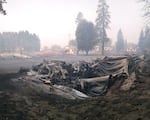
An Oregon Department of Fish and Wildlife hatchery building was destroyed by the Two Four Two Fire near Klamath Agency, north of Klamath Lake. Fish in tanks near the building seemed unharmed.
Brandon Swanson / OPB
PORTLAND, Ore. (AP) — As wildfires raged through Oregon, staff at fish hatcheries around the state raced to try to save – or prematurely release – millions of chinook salmon, steelhead and trout being raised in captivity to preserve fragile fish species, state officials said Thursday.
About 450,000 fish perished at two hatcheries combined and nearly 1.2 million chinook, steelhead and trout were released into the McKenzie River east of Eugene all at once in desperation as the fire approached and fresh water to the facility was cut off. Other hatcheries lost critical infrastructure, including a hatchery building near the Oregon-California border, and one facility went ahead with a critical breeding period while running on limited power from a back-up generator.
State wildlife officials are still assessing the extent of the damage and the impact of the mass deaths and mass releases on the hatchery program and the full situation might not be clear for weeks, said ODFW's Deputy Director Shannon Hurn. The agency is also bracing for mudslides that occur when winter rains hit the burned areas and push debris into rivers and streams.
“We are still very much in the emergency response phase," Hurn said.
About 400,000 juvenile coho, spring Chinook, winter steelhead and rainbow trout native to the Umpqua Basin died at a hatchery in Idleyld Park on the Umpqua River. Another 50,000 brown trout perished at the Klamath Hatchery in Chiloquin.
Staff at the Leaburg Hatchery east of Eugene, where fires raged, worked in smoke-choked air to empty fish pens of more than 1.1 million fish and clear adult spring chinook from fish ladders before fleeing themselves as flames crested the hill and ash rained down, said Erik Withalm, the hatchery's manager for the Oregon Department of Fish and Wildlife facility.
“At one point, when we were working in the very last pond, it was so bright (from the fire) it was almost daylight,” he said in a phone interview. “I looked over my shoulder and there were flames coming up over the hill toward the houses, so we know that we finished the task we went in to do right when the fire started coming over.”
The hatchery was forced to release so many fish because the local utility opened the gates of Leaburg Dam to prevent it from clogging up with debris during the fire. That drained the lake so low that the hatchery no longer had fresh water for the fish.
“Really this is so unprecedented that we don’t know what the impacts will be, but we do know the fish aren't dead in the ponds,” Withalm said of the released fish.
Those fish will be completing their migratory life cycle to the Pacific Ocean and back in anywhere between two and five years. Fish biologists should be able to study their survivability and how the fires impacted them by identifying them through tiny tracking tags implanted in the fish, he said.
At the Minto Hatchery near Gates, an area almost completely wiped out by the fire, hatchery staff have been able to spawn 840,000 eggs from spring chinook stock this week despite mandatory evacuations and limited power. Another 900,000 eggs are expected from the adults in the next few days, said ODFW hatchery manager Greg Grenbemer.
“We got hit pretty hard,” he said in a phone interview Thursday. “I talk about miracles and the hand of God — and I think both of them played a part in this.”
The Oregon Department of Fish and Wildlife operates 33 fish hatcheries around the state where several species of salmon, steelhead and trout are raised to help sustain fish populations that are in decline and to stock waterbodies to provide fishing opportunities. Hatchery managers and some other staff live onsite providing daily care to these fish until they are released.
____
Follow Gillian Flaccus on Twitter at http://www.twitter.com/gflaccus